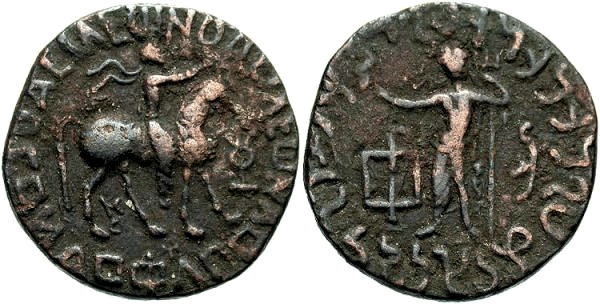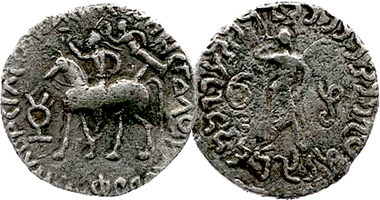
|
|
|
|
BY: SUN STAFF

Coins of the Indo-Parthian Kings of Gondophares Apr 10, 2015 — CANADA (SUN) — A serial presentation of India's great history, religious movements and temple architecture.
The Indo-Parthians
With the rise of the Parthians, the Indus Valley was once again brought under the influence of Persia as they conquered the Indo-Scythians. The Indo-Parthian Kingdom was founded by Gondophares around 20 BCE when he declared his Independence from the Parthians. The kingdom lasted only briefly, until its conquest by the Kushans in the late 1st Century A.C. The kingdom was actually a loosely organized realm within which many smaller dynasties maintained their independence.
The earliest representations of Lord Siva are found on some of the coins of the Indo-Parthian king Gondophares. Siva is depicted holding a trident in one hand while the other hand is either empty or holds a palm (or chamar). One of Gondophare's titles on his coin legends, devavrata, 'devoted to gods', indicates that he had adopted the Vaisnava worship of the devas as distinguished from the Islamist worship of the Ahuras.
Questions as to how ancient Vaisnava and Middle Eastern cultures became blended often arise in discussions of the inscription of Heliodorus on the famous Garuda column at Vidisha (near modern Besnagar). How could an alien, a 'yona' or Yavana like Heliodorus become a Bhagavata (Vaishnava)? In fact, early Indian coins and inscriptions reveal to us the names of other alien invaders and immigrants who were likewise Brahmanised in their religious practices. The coins of the Indo-Parthian Gondophares kings are such an example.
The Indo-Parthian king Gondophares ruled an empire that stretched across much of modern-day Afghanistan and Pakistan, and into what is today known as northern India.
There were several different kings in the line who had the name Gondophares. The Gondophares' reign dates from the 1st Century B.C. through the late 1st Century A.D. The Gondophares coins minted with images of Siva are dated to somewhere between 10 B.C. and 10 B.C.

In the image just above, we see the likeness of Kong Gondophareas, riding horseback. Nike, the Greek goddess of Victory, flies behind him, holding a wreath above him. Gondophares is wearing traditional Parthian dress and holds a whip. The symbol in front of the horse is the tamgha of Gondophares, a royal seal unique to his rule. The Greek script around the obverse of the coin reads 'Gondophares, King of Kings' . The coin's verso shows Lord Siva, who is holding a trident and a palm branch. The symbols to the left and right of Shiva seem to be a form of Kharoshti monograms. The inscription around is also in Kharoshti script, and reads the same as the obverse. [11a] FOOTNOTES: [11a] Coinquest.com
| |